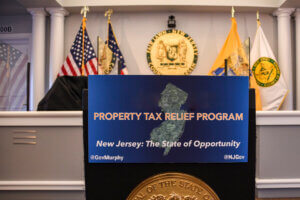A recent Monmouth University Poll found that a majority (59%) of adults in the Garden State have listened to talk radio. This includes more than 1-in-4 (27%) who tune into a radio talk program nearly every day and another 18% who do so at least once a week. Another 40% say they never listen to talk radio.
Among weekly listeners there is a decided gender gap – 53% of men compared to 38% of women listen to talk radio at least once a week. Talk radio also has more appeal to those in the middle age category – 51% of New Jerseyans age 30 to 49 are weekly listeners, compared to 41% of those age 50 and older and 40% of those under 30. Talk radio also gains a larger audience among those with a college education – 52% of college graduates and 47% with some college listen to talk radio on at least a weekly basis, compared to 39% of adults who have never attended college.
The top talk station among listeners is a home-grown one. More than 1-in-4 Garden State talk radio listeners (27%) say their most listened to station is New Jersey 101.5. In second place is New York’s WABC 77 at 16%. The next three slots are occupied by the various NPR outlets serving the region (including WNYC and WHYY) at 8%, WOR 710 at 7%, and The FAN 660 at 7%. Philadelphia stations The Big Talker 1210 (3%) and WIP 610 sports talk (2%) also register among the state’s favorites. A variety of music-oriented stations that have morning drive time talk programming were listed by 19% of New Jersey’s talk radio listeners. Satellite talk radio is favored by 5% of listeners.
Patrick Murray, director of the Monmouth University Polling Institute, commented, “Talk radio may be the top source of water cooler conversation. And in a state without a strong media identity, a good number of New Jerseyans look for outlets with a Garden State flavor.”
Looking at the poll results by region of the state, New Jersey101.5 is a favorite of more than one-third of the talk radio audience in Central and South Jersey, where its signal is strongest. WCTC 1450 also makes the list of top stations in Central Jersey.
| Top Talk Radio Stations by New Jersey Region | ||
| North | Central | South |
| Music w/am talk (21%) WABC (19%) NJ 101.5 (15%) WOR (9%) The FAN (8%) NPR (8%) | NJ 101.5 (39%) WABC (18%) Music w/am talk (18%) NPR (12%) WOR (9%) The FAN (6%) WCTC (4%) | NJ 101.5 (35%) Music w/am talk (19%) WABC (8%) The FAN (8%) Big Talker (6%) WIP (6%) NPR (6%) |
— Political Differences
There are some notable partisan differences among New Jersey devotees of the genre. Republicans (50%) and independents (49%) are more likely than Democrats (38%) to be weekly talk radio listeners.
The poll, which was conducted during the recent U.S. Senate campaign, found that the voting intentions of weekly listeners was split – 45% for Democrat Bob Menendez to 43% for Republican Tom Kean. On the other hand, Menendez commanded a sizable 52% to 34% lead among voters who never listen to talk radio or do so only occasionally. Among listeners of the top talk station New Jersey 101.5 specifically, 40% preferred Menendez to 34% for Kean, with a large 25% undecided as of late October.
Murray remarked “It’s unclear whether undecided voters tuned into talk radio to help them decide or whether listening to talk radio made them more undecided.” Menendez eventually went on to win election to the U.S. Senate by 9 points.
The Monmouth University Poll was conducted by telephone with 800 New Jersey adults from October 16-19, 2006. This sample has a margin of error of ± 3.5 percent.
DATA TABLES
The questions referred to in this release are as follows:
(* Some columns may not add to 100% due to rounding.)
1. Do you ever listen to talk radio? [IF “YES”:] How often have you listened in the past month – 4 to 5 times a week, 1 to 3 times a week, less often, or not in the past month?
|
TOTAL | Likely Voter | PARTY ID | GENDER | EDUCATION |
AGE | ||||||||||
|
Dem | Ind | Rep | Male | Female | HS or less | Some Coll | Coll grad | 18-29 | 30-49 |
50+ | |||||
| Yes, 4 to 5 times a week | 27% | 32% | 24% | 31% | 27% | 32% | 23% | 22% | 29% | 34% | 19% | 34% | 24% | ||
| Yes, 1 to 3 times a week | 18% | 17% | 14% | 18% | 23% | 21% | 15% | 17% | 18% | 18% | 21% | 17% | 17% | ||
| Yes, less often | 10% | 11% | 16% | 5% | 7% | 7% | 12% | 10% | 10% | 9% | 9% | 11% | 9% | ||
| Yes, but not in the past month | 4% | 5% | 3% | 5% | 5% | 4% | 5% | 4% | 3% | 6% | 2% | 3% | 7% | ||
| NO, never listen | 40% | 33% | 42% | 39% | 38% | 34% | 45% | 46% | 39% | 31% | 47% | 33% | 42% | ||
| No answer | 1% | 1% | 1% | 1% | 1% | 1% | 1% | 0% | 0% | 2% | 1% | 1% | 1% | ||
| Unweighted N |
800 | 396 | 262 | 315 | 196 | 386 | 414 | 227 | 200 | 368 | 98 | 324 |
374 | ||
2. Which stations do you listen to most often?
Among those who have listened in the past month:
| More than one response accepted, may total more than 100% |
TOTAL |
Listening Frequency | |||
|
4+ times | 1-3 times a week |
Past | |||
| New Jersey 101.5 | 27% | 25% | 28% | 27% | |
| WABC 770 | 16% | 18% | 18% | 8% | |
| NPR/WNYC/WHYY | 8% | 11% | 5% | 4% | |
| WOR 710 | 7% | 9% | 9% |
<1% | |
| The FAN 660 | 7% | 11% | 5% | 2% | |
| Big Talker 1210 | 3% | 3% | 5% |
–% | |
| WIP 610 | 2% | 3% | 1% | 1% | |
| WCTC 1450 | 1% | 2% | 1% |
–% | |
| Satellite (XM/Sirius) | 5% | 6% | 6% | 1% | |
| Music stations with am talk | 19% | 19% | 17% | 25% | |
| Unweighted N |
473 | 251 | 145 |
77 | |
Results for this Monmouth University Poll are based on telephone interviews conducted by the Monmouth University Polling Institute on October 16-19, 2006 with a statewide random sample of 800 adult residents. For results based on the total sample, one can say with 95% confidence that the error attributable to sampling has a maximum margin of plus or minus 3.5 percentage points. Sampling error increases as the sample size decreases, so statements based on various population subgroups, such as separate figures reported by gender or party identification, are subject to more error than are statements based on the total sample. In addition to sampling error, one should bear in mind that question wording and practical difficulties in conducting surveys can introduce error or bias into the findings of opinion polls.
It is the Monmouth University Polling Institute’s policy to conduct surveys of all adult New Jersey residents, including voters and non-voters, on issues which affect the state. Specific voter surveys are conducted when appropriate during election cycles.
Click on pdf file link below for full methodology and results by key demographic groups.




